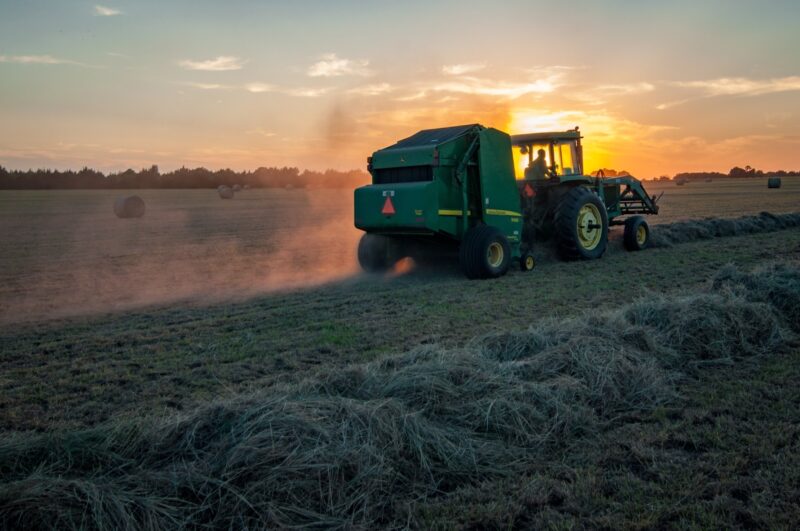Climate models underestimate food security risk from ‘compound’ extreme weather
Climate change poses a risk to global food security. Weather and climate extremes, such as prolonged drought, heavy rainfall and heatwaves, can lead to harvest failures. These are occurring with increased magnitude and frequency on a warming planet. In addition, such events can disrupt supply chains, decreasing food supply and leading to price spikes.
Share

Our previous work shows that when extreme weather events happen simultaneously – such as a heatwave and drought at the same time – this can negatively affect crop yields in major crop-producing regions, known as “breadbaskets”.
This co-occurrence constitutes a growing food security risk.
In our latest paper, published in Nature Communications, we highlight factors that can lead to low crop yields in several breadbasket regions simultaneously. We also examine how well state-of-the-art climate and crop models are able to reproduce observed relationships.
We find that climate models tend to underestimate the risks of concurrent extreme weather events, potentially leading to “blind spots” in our understanding of future implications.
Complex climate risks
Ensuring global food security under changing climate conditions is a global challenge.
Meeting this challenge relies on reliable projections of future climate conditions, in order to establish reasonable and preventive adaptation measures.
Such assessments are not trivial. They rely on “coupled” experiments that combine both climate models and crop models. The projections must also be done for a range of emissions scenarios in order to fully understand the risk.
Climate extremes are rare, but impactful, events. The accuracy with which we can determine future climate risks for agriculture depends on the skill of climate models in accurately reproducing their frequency and magnitude, as well as the crop models’ accuracy in simulating crop responses.
Research shows that increasingly complex climate risks, in which several extremes interact, are a direct consequence of rising extreme weather trends.
More and longer-lasting extremes translate to higher likelihoods of consecutive climate disasters.
For example, two hurricanes in a row hitting the same region; several different disasters occurring at the same place at the same time, such as concurrent heatwaves and drought; or multiple disasters occurring at the same time globally, such as heatwaves in multiple regions.
Such “compound” events are usually associated with greater impacts, often beyond the sum of the effects had each disaster occurred in isolation. Interacting effects put extra stress on existing vulnerability, disaster preparedness and disaster response measures.
For instance, heatwaves are particularly disastrous for local crop production if they occur in unison with intense drought conditions. Consecutive heatwaves in a region can cause crops to fail that might have survived a solo event.
‘Breadbaskets’
From a global food security perspective, simultaneous extremes are particularly problematic as they could lead to harvest failures in several crop-producing regions – known as “breadbaskets” – at the same time.
As a result, countries that rely heavily on crop imports could experience heightened food insecurity, as global scarcity could lead to price spikes and even result in national export bans.
Many breadbasket regions, such as central North America, western and eastern Europe and Asia, are located in the temperate climate zones of the mid-latitudes. In these regions, weather patterns are controlled by the jet stream, a current of fast-flowing air that encircles the globe.
The important role of the jet stream in driving extreme weather conditions has been illustrated by some of the most extraordinary climate events of the past few years.
In 2021, the record-shattering “heat dome in the Pacific north-west that fuelled wildfires and caused hundreds of deaths was directly linked to an intense “ridge” in the jet stream. This caused a high-pressure system to linger over the region. Likewise, the record-breaking heatwaves in Europe in 2018 and 2019 were associated with a meandering, wavy jet stream.
Often, these meanders – also referred to as Rossby waves – expand over larger parts of the globe, promoting extremes in several regions at the same time. In 2022, during the northern hemisphere summer, a strongly meandering jet led to synchronised extremes in the US, Europe and China. Media outlets at the time were quick to point out the links between the heatwaves.
The map below shows surface temperature anomalies across the northern hemisphere during the week of 18 July 2022, with red indicating higher than average temperatures. The concurrence of the five heatwaves – marked with circles – was caused by the meandering jet stream.

Our previous work has shown that certain jet stream patterns can not only enhance the concurrence of extreme weather events, but also negatively affect crop yields in major breadbasket regions.
In our latest paper, we show that summers with strongly meandering jet stream patterns favour the co-occurrence of low crop yields in several pairs of major crop-producing regions, increasing the probability of such events by a factor of three in some regions. This constitutes a risk for food security.
Meandering jet stream
Given the jet stream’s importance for weather and climate events – and the outsized impacts of those extremes on societal systems, such as agricultural production – quantifying its response to climate change is an important problem to solve.
Previous research has suggested that future climate change will lead to an increase in persistent extreme weather. So far, observations have not confirmed the suggested changes in the frequency of a highly meandering jet stream. However, rising background temperatures will make the heatwaves associated with such patterns more impactful, even if their frequency is unchanged.
Our new research looks at observed declines in crop yields that occurred during jet stream meandering events between 1960-2014. We compare the observations to a crop model driven by the Copernicus/ECMWF global atmospheric reanalysis product (ERA5) and coupled crop-climate models, part of the latest generation under the Coupled Model Intercomparison Project (CMIP6).
In addition to looking at how well the models can recreate historical data, we examine future responses for the years 2045-99 under a scenario known as SSP5-8.5. SSP5-8.5 is one of a set of “pathways that examine how the world might change over the next century. With this approach we are able to discuss sources of uncertainties in the crop response modelling chain.
Of the full set of pathways available, SSP5-8.5 is essentially a worst-case scenario of unchecked warming – and many may consider it to be unrealistic.
But it is the extreme nature of this scenario that makes it useful for comparing impacts in models and observations. Our conclusions are not based on this particular projection and have more general implications.
Underestimation
Our results suggest that climate models do not exhibit a significant increase in the frequency of meandering jet patterns under the very high emissions SSP5-8.5 scenario.
Most importantly, we find that while current climate models represent the position and intensity of the meandering jets, they do not accurately reproduce the magnitude of local temperature anomalies. This, therefore, underestimates the impact these meanders have for extreme weather events.
This underestimation has previously been shown for older climate models, but we now show that a similar issue persists in the newest generation of models used for impact studies.
Additionally, we identify regions that are likely to experience amplified heat on top of average shifts in regional climatologies due to these meanders. North America and Siberia, two areas that have suffered from extraordinary extreme weather in the recent past, are at heightened risk.
The challenge
It is perhaps widely accepted that climate models can struggle with the depiction of extreme weather events.
Understanding the intricate risks related to climate change requires precise representation of the position, scale, frequency and timing of extreme weather events. How all of these change in the future depends on the different emissions scenarios.
While climate models project the average response of the Earth system to ongoing greenhouse gas emissions, our analysis suggests these models may underestimate the potential impact of concurrent extreme weather events on regional crop yields and the consequences of their synchronised failure.
Standing waves in the jet stream have been important ingredients of many past record-breaking weather extremes, such as the heatwave that affected the Pacific north-west in summer 2021. An accurate representation of surface temperature anomalies associated with such patterns is crucial for understanding accelerated trends in these extremes.
Our study reveals that current climate risk assessments may be overlooking sectors and regions at high risk from the complex interactions of several extremes, often linked to dynamical mechanisms in the atmosphere and climate change.
This highlights the pressing need for more empirical and process-based research to improve models relating to both climate and agriculture.
The underestimation of synchronised low yields, as well as other areas of high risk, emphasises how the complexity of climate extremes may increase without rapid emissions reductions, perhaps to the point of becoming unmanageable.
This guest post was first published on Carbon Brief.












